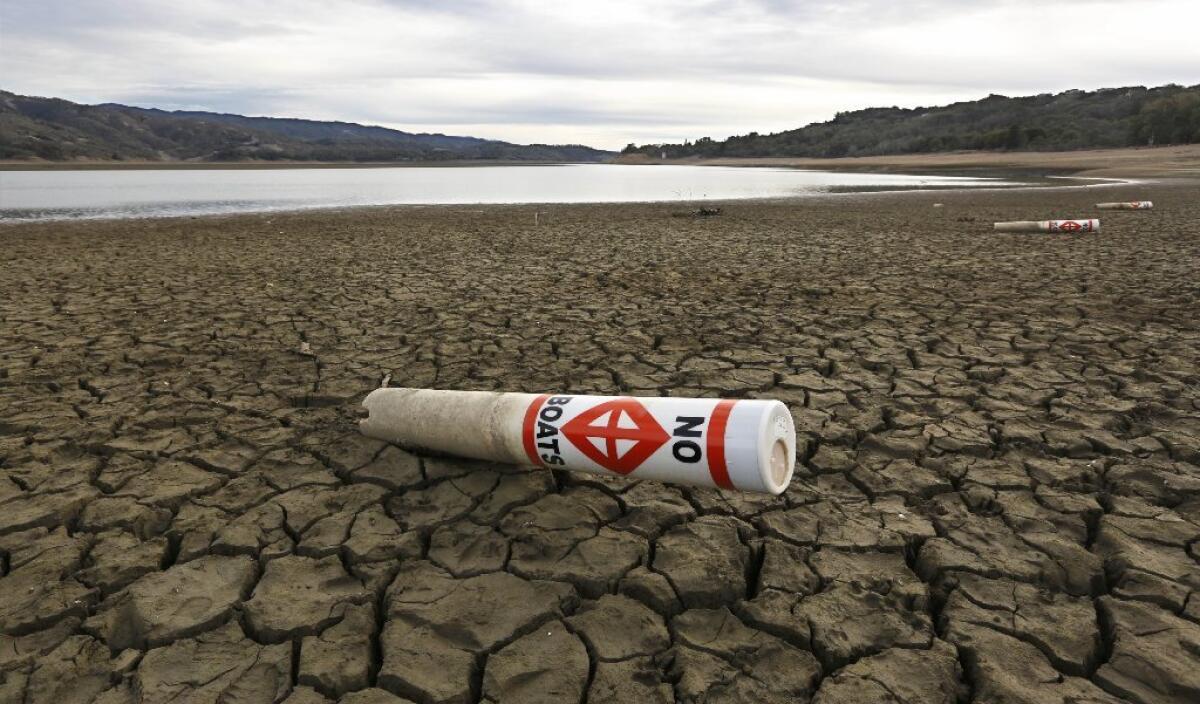The contentious, complicated fight for water in California

- Share via
California’s water system is an engineering marvel, a testament to generations of sustained investment and a vast, complex web of infrastructure. It makes Los Angeles possible. It is also in trouble.
The system’s brilliance is that a snowflake can fall in the Sierra, trickle down the western slope, drift through the Bay Delta and into the state water system and then travel hundreds of miles and over mountains to Southern California. The system’s delicacy was on display this month when that melted snowflake burst through a broken water main on Sunset Boulevard and ended up in a flood at UCLA.
And if Los Angeles’ water infrastructure is in need of help, so is the state’s, where the stakes are even higher and the debates over who gets water and how to pay for it are invariably fierce.
------------
FOR THE RECORD:
Water: The caption for the photograph that illustrated Jim Newton’s Aug. 11 column on a water bond was incorrect. The Los Angeles Aqueduct was pictured, not the California Aqueduct. —
------------
Last week’s maneuvering over a proposed water bond for the November ballot was a case in point. Proponents have been pushing a bond for years, but the proposal they initially put together was so larded up with extras — bike paths, museums and other pet projects intended to ensure the votes of legislators whose districts they fell in — that it crumbled under its own weight.
This time, famously frugal Gov. Jerry Brown has counterpunched. He announced his “no-frills, no-pork” proposal last week, trimming the $11.1-billion package to $6 billion. If approved, it would fund dams, reclamation and ecosystem restoration, among other things, though at lower levels than many want.
The objections came swiftly. Agricultural interests complained that $2 billion allocated for dams wasn’t enough. Assembly Speaker Toni Atkins worried the package was too small overall (only in California would a $6-billion bond strike anyone as small).
And farmers and environmentalists in the delta raised their own, unique concern: They are fearful of a proposed pair of tunnels that would divert Sacramento River water to Southern California, and even though this package includes no money for that project, they worry that investment in habitat protection could make the tunnels easier to build down the road. They’re now in the odd position of questioning ecosystem restoration even though they’re fighting to protect an ecosystem.
Jeff Kightlinger is general manager of the Metropolitan Water District, which supplies much of Southern California with its water, and he’s seen these debates before. When I asked him last week about the delta group’s response to the ecosystem investment, Kightlinger let out a long sigh. “Well, they’re free to oppose anything,” he said. But the bond would invest more than $1 billion in watershed protection and ecosystem restoration throughout the state; defeating it to block the tunnels would be a high price.
Water politics, always complex, are particularly tricky this time. Critics of the delta tunnels may withhold their support, which would leave supporters in search of a few Republican votes to reach the two-thirds necessary in the Legislature. They’re likely to insist on more dams, however, which would push up the price and risk losing other potential backers, even Brown himself.
Yet one historical divide on these issues has gradually receded. I grew up in the Bay Area, where in the 1970s common wisdom held that Los Angeles was stealing San Francisco water and using it to hose down driveways and fill swimming pools. The state has grown up since then, and that caricature — never quite true, and much less so today — has faded. As even my old neighbors would now grudgingly admit, Los Angeles has made extraordinary strides in curtailing water use, and that helps the entire state. Every drop not used here is a half-drop not taken from somewhere else (typically, L.A. gets about half of its water from the State Water Project; this year, it’s been higher, about 75%).
The bond would not invest in Los Angeles water infrastructure, the source of the recent troubles at UCLA. But Marcie Edwards, general manager of the Department of Water and Power, said it’s crucial anyway. She’s pressing for an increase in the amount of groundwater cleanup it would fund — an especially important priority here, as contamination beneath the San Fernando Valley limits the city’s ability to store water once it arrives. Moreover, money for groundwater cleanup could free up other money locally — to address infrastructure, for example.
It takes water to survive. And in California, it takes a monumental effort to capture that water and get it where it’s needed. After all, as Kightlinger noted, in California “the people do not live where the water is.”
jim.newton@latimes.com
Twitter: @newton_jim
More to Read
Sign up for Essential California
The most important California stories and recommendations in your inbox every morning.
You may occasionally receive promotional content from the Los Angeles Times.














